
Fundamentals of Microelectronics
.pdf
BR |
Wiley/Razavi/Fundamentals of Microelectronics [Razavi.cls v. 2006] |
June 30, 2007 at 13:42 |
1 (1) |
|
|
|
|
Introduction to Microelectronics
Over the past five decades, microelectronics has revolutionized our lives. While beyond the realm of possibility a few decades ago, cellphones, digital cameras, laptop computers, and many other electronic products have now become an integral part of our daily affairs.
Learning microelectronics can be fun. As we learn how each device operates, how devices comprise circuits that perform interesting and useful functions, and how circuits form sophisticated systems, we begin to see the beauty of microelectronics and appreciate the reasons for its explosive growth.
This chapter gives an overview of microelectronics so as to provide a context for the material presented in this book. We introduce examples of microelectronic systems and identify important circuit “functions” that they employ. We also provide a review of basic circuit theory to refresh the reader's memory.
1.1 Electronics versus Microelectronics
The general area of electronics began about a century ago and proved instrumental in the radio and radar communications used during the two world wars. Early systems incorporated “vacuum tubes,” amplifying devices that operated with the flow of electrons between plates in a vacuum chamber. However, the finite lifetime and the large size of vacuum tubes motivated researchers to seek an electronic device with better properties.
The first transistor was invented in the 1940s and rapidly displaced vacuum tubes. It exhibited a very long (in principle, infinite) lifetime and occupied a much smaller volume (e.g., less than 1 cm3 in packaged form) than vacuum tubes did.
But it was not until 1960s that the field of microelectronics, i.e., the science of integrating many transistors on one chip, began. Early “integrated circuits” (ICs) contained only a handful of devices, but advances in the technology soon made it possible to dramatically increase the complexity of “microchips.”
Example 1.1
Today's microprocessors contain about 100 million transistors in a chip area of approximately 3 cm 3 cm. (The chip is a few hundred microns thick.) Suppose integrated circuits were not invented and we attempted to build a processor using 100 million “discrete” transistors. If each device occupies a volume of 3 mm 3 mm 3 mm, determine the minimum volume for the processor. What other issues would arise in such an implementation?
Solution
The minimum volume is given by 27 mm3 108, i.e., a cube 1.4 m on each side! Of course, the
1

BR |
Wiley/Razavi/Fundamentals of Microelectronics [Razavi.cls v. 2006] |
June 30, 2007 at 13:42 |
2 (1) |
|
|
|
|
2 |
Chap. 1 |
Introduction to Microelectronics |
wires connecting the transistors would increase the volume substantially.
In addition to occupying a large volume, this discrete processor would be extremely slow; the signals would need to travel on wires as long as 1.4 m! Furthermore, if each discrete transistor costs 1 cent and weighs 1 g, each processor unit would be priced at one million dollars and weigh 100 tons!
Exercise
How much power would such a system consume if each transistor dissipates 10 W?
This book deals with mostly microelectronics while providing sufficient foundation for general (perhaps discrete) electronic systems as well.
1.2 Examples of Electronic Systems
At this point, we introduce two examples of microelectronic systems and identify some of the important building blocks that we should study in basic electronics.
1.2.1 Cellular Telephone
Cellular telephones were developed in the 1980s and rapidly became popular in the 1990s. Today's cellphones contain a great deal of sophisticated analog and digital electronics that lie well beyond the scope of this book. But our objective here is to see how the concepts described in this book prove relevant to the operation of a cellphone.
Suppose you are speaking with a friend on your cellphone. Your voice is converted to an electric signal by a microphone and, after some processing, transmitted by the antenna. The signal produced by your antenna is picked up by the your friend's receiver and, after some processing, applied to the speaker [Fig. 1.1(a)]. What goes on in these black boxes? Why are they needed?
Transmitter (TX) |
Receiver (RX) |
Microphone |
Speaker |
? |
? |
(a) |
(b) |
Figure 1.1 (a) Simplified view of a cellphone, (b) further simplification of transmit and receive paths.
Let us attempt to omit the black boxes and construct the simple system shown in Fig. 1.1(b). How well does this system work? We make two observations. First, our voice contains frequencies from 20 Hz to 20 kHz (called the “voice band”). Second, for an antenna to operate efficiently, i.e., to convert most of the electrical signal to electromagnetic radiation, its dimension must be a significant fraction (e.g., 25%) of the wavelength. Unfortunately, a frequency range of 20 Hz to 20 kHz translates to a wavelength1 of 1:5 107 m to 1:5 104 m, requiring gigantic antennas for each cellphone. Conversely, to obtain a reasonable antenna length, e.g., 5 cm, the wavelength must be around 20 cm and the frequency around 1.5 GHz.
1Recall that the wavelength is equal to the (light) velocity divided by the frequency.
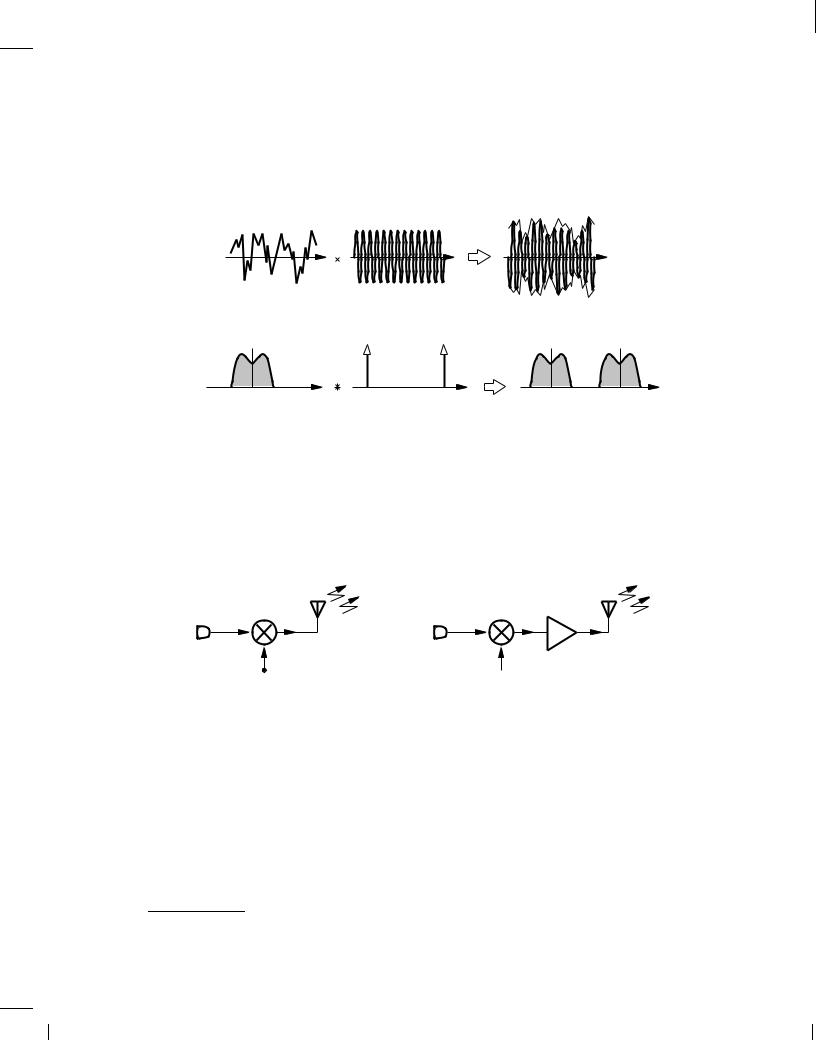
BR |
Wiley/Razavi/Fundamentals of Microelectronics [Razavi.cls v. 2006] |
June 30, 2007 at 13:42 |
3 (1) |
|
|
|
|
Sec. 1.2 |
Examples of Electronic Systems |
3 |
How do we “convert” the voice band to a gigahertz center frequency? One possible approach is to multiply the voice signal, x(t), by a sinusoid, A cos(2 fct) [Fig. 1.2(a)]. Since multiplication in the time domain corresponds to convolution in the frequency domain, and since the spectrum
x (t ) |
A cos( 2 π f C t ) |
Output Waveform |
|
||
Voice |
|
|
Signal |
|
|
t |
t |
t |
|
(a) |
|
Voice
Spectrum
−20 kHz
X (f )
0 kHz +20
|
Spectrum of Cosine |
Output Spectrum |
||||
f |
− f C |
0 |
+ f C f |
− f C |
0 |
+ f C f |
|
|
(b) |
|
|
|
|
Figure 1.2 (a) Multiplication of a voice signal by a sinusoid, (b) equivalent operation in the frequency domain.
of the sinusoid consists of two impulses at fc, the voice spectrum is simply shifted (translated) to fc [Fig. 1.2(b)]. Thus, if fc = 1 GHz, the output occupies a bandwidth of 40 kHz centered at 1 GHz. This operation is an example of “amplitude modulation.” 2
We therefore postulate that the black box in the transmitter of Fig. 1.1(a) contains a multiplier,3 as depicted in Fig. 1.3(a). But two other issues arise. First, the cellphone must deliver
Power
Amplifier
A cos( 2 π f C t ) |
Oscillator |
|
|
(a) |
(b) |
Figure 1.3 (a) Simple transmitter, (b) more complete transmitter.
a relatively large voltage swing (e.g., 20 Vpp) to the antenna so that the radiated power can reach across distances of several kilometers, thereby requiring a “power amplifier” between the multiplier and the antenna. Second, the sinusoid, A cos 2 fct, must be produced by an “oscillator.” We thus arrive at the transmitter architecture shown in Fig. 1.3(b).
Let us now turn our attention to the receive path of the cellphone, beginning with the simple realization illustrated in Fig. 1.1(b). Unfortunately, This topology fails to operate with the principle of modulation: if the signal received by the antenna resides around a gigahertz center frequency, the audio speaker cannot produce meaningful information. In other words, a means of
2Cellphones in fact use other types of modulation to translate the voice band to higher frequencies.
3Also called a “mixer” in high-frequency electronics.
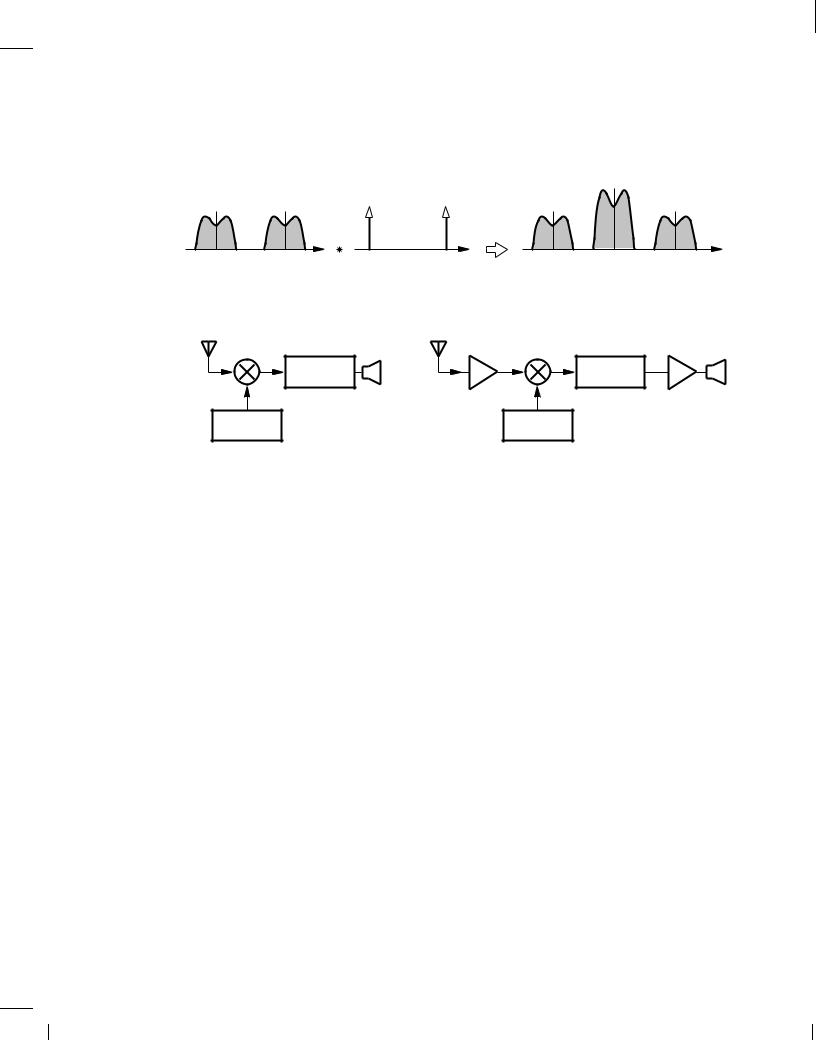
BR |
Wiley/Razavi/Fundamentals of Microelectronics [Razavi.cls v. 2006] |
June 30, 2007 at 13:42 |
4 (1) |
|
|
|
|
4 |
Chap. 1 |
Introduction to Microelectronics |
translating the spectrum back to zero center frequency is necessary. For example, as depicted in Fig. 1.4(a), multiplication by a sinusoid, A cos(2 fct), translates the spectrum to left and right by
|
|
|
|
|
|
|
Output Spectrum |
|
|
Received Spectrum |
Spectrum of Cosine |
|
|
|
|
||||
− f C |
0 |
+ f C f |
− f C |
0 |
+ f C f |
−2 f C |
0 |
+2 f C |
f |
|
|
|
|
|
(a) |
|
|
|
|
|
|
|
|
|
Low−Noise |
|
|
|
|
|
|
|
|
|
Amplifier |
|
|
Amplifier |
|
|
|
Low−Pass |
|
|
|
|
Low−Pass |
|
|
|
|
Filter |
|
|
|
|
Filter |
|
|
oscillator |
|
|
|
|
oscillator |
|
|
|
|
|
|
(b) |
|
|
|
(c) |
|
|
|
Figure 1.4 (a) Translation of modulated signal to zero center frequency, (b) simple receiver, (b) more complete receiver.
fc, restoring the original voice band. The newly-generated components at 2fc can be removed by a low-pass filter. We thus arrive at the receiver topology shown in Fig. 1.4(b).
Our receiver design is still incomplete. The signal received by the antenna can be as low as a few tens of microvolts whereas the speaker may require swings of several tens or hundreds of millivolts. That is, the receiver must provide a great deal of amplification (“gain”) between the antenna and the speaker. Furthermore, since multipliers typically suffer from a high “noise” and hence corrupt the received signal, a “low-noise amplifier” must precede the multiplier. The overall architecture is depicted in Fig. 1.4(c).
Today's cellphones are much more sophisticated than the topologies developed above. For example, the voice signal in the transmitter and the receiver is applied to a digital signal processor (DSP) to improve the quality and efficiency of the communication. Nonetheless, our study reveals some of the fundamental building blocks of cellphones, e.g., amplifiers, oscillators, and filters, with the last two also utilizing amplification. We therefore devote a great deal of effort to the analysis and design of amplifiers.
Having seen the necessity of amplifiers, oscillators, and multipliers in both transmit and receive paths of a cellphone, the reader may wonder if “this is old stuff” and rather trivial compared to the state of the art. Interestingly, these building blocks still remain among the most challenging circuits in communication systems. This is because the design entails critical trade-offs between speed (gigahertz center frequencies), noise, power dissipation (i.e., battery lifetime), weight, cost (i.e., price of a cellphone), and many other parameters. In the competitive world of cellphone manufacturing, a given design is never “good enough” and the engineers are forced to further push the above trade-offs in each new generation of the product.
1.2.2 Digital Camera
Another consumer product that, by virtue of “going electronic,” has dramatically changed our habits and routines is the digital camera. With traditional cameras, we received no immediate
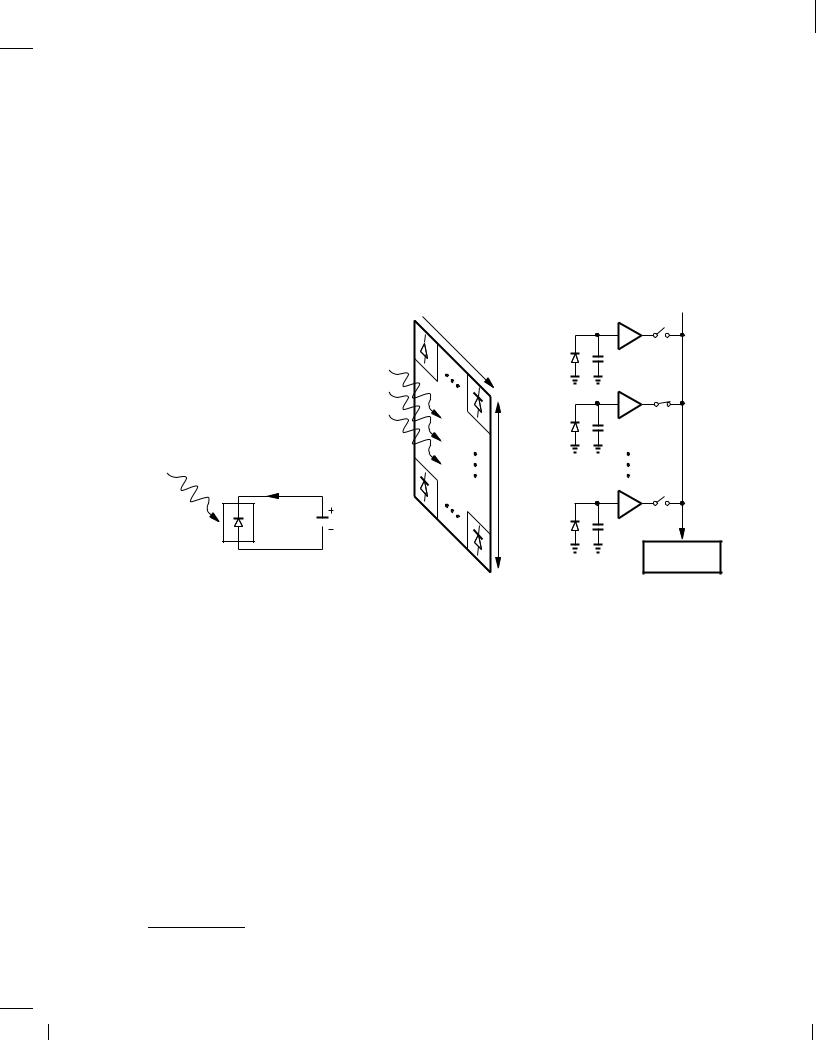
BR |
Wiley/Razavi/Fundamentals of Microelectronics [Razavi.cls v. 2006] |
June 30, 2007 at 13:42 |
5 (1) |
|
|
|
|
Sec. 1.2 |
Examples of Electronic Systems |
5 |
feedback on the quality of the picture that was taken, we were very careful in selecting and shooting scenes to avoid wasting frames, we needed to carry bulky rolls of film, and we would obtain the final result only in printed form. With digital cameras, on the other hand, we have resolved these issues and enjoy many other features that only electronic processing can provide, e.g., transmission of pictures through cellphones or ability to retouch or alter pictures by computers. In this section, we study the operation of the digital camera.
The “front end” of the camera must convert light to electricity, a task performed by an array (matrix) of “pixels.” 4 Each pixel consists of an electronic device (a “photodiode” that produces a current proportional to the intensity of the light that it receives. As illustrated in Fig. 1.5(a), this current flows through a capacitance, CL, for a certain period of time, thereby developing a
 2500
2500  Colum ns
Colum ns
Amplifier
I Diode
Light
CL  Vout
Vout
Photodiode
2500 Rows
Signal
Processing
(a) |
(b) |
(c) |
Figure 1.5 (a) Operation of a photodiode, (b) array of pixels in a digital camera, (c) one column of the array.
proportional voltage across it. Each pixel thus provides a voltage proportional to the “local” light density.
Now consider a camera with, say, 6.25-million pixels arranged in a 2500 2500 array [Fig. 1.5(b)]. How is the output voltage of each pixel sensed and processed? If each pixel contains its own electronic circuitry, the overall array occupies a very large area, raising the cost and the power dissipation considerably. We must therefore “time-share” the signal processing circuits among pixels. To this end, we follow the circuit of Fig. 1.5(a) with a simple, compact amplifier and a switch (within the pixel) [Fig. 1.5(c)]. Now, we connect a wire to the outputs of all 2500 pixels in a “column,” turn on only one switch at a time, and apply the corresponding voltage to the “signal processing” block outside the column. The overall array consists of 2500 of such columns, with each column employing a dedicated signal processing block.
Example 1.2
A digital camera is focused on a chess board. Sketch the voltage produced by one column as a function of time.
4The term “pixel” is an abbreviation of “picture cell.”
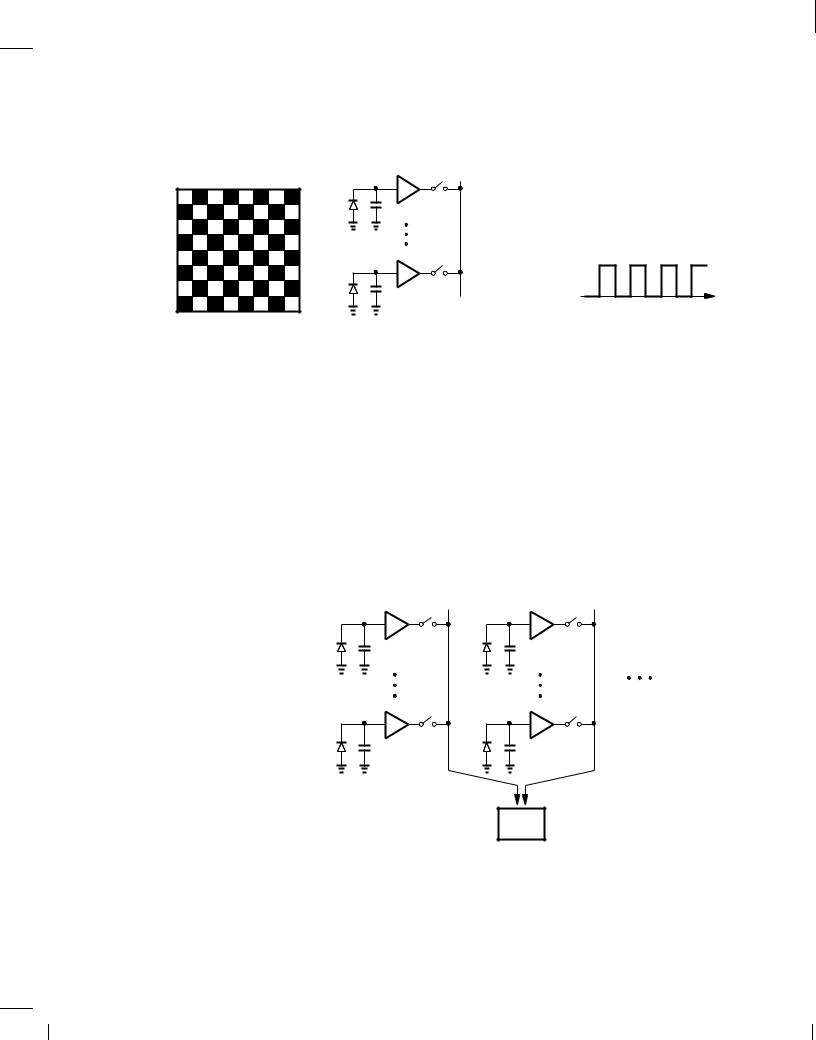
BR |
Wiley/Razavi/Fundamentals of Microelectronics [Razavi.cls v. 2006] |
June 30, 2007 at 13:42 |
6 (1) |
|
|
|
|
6 |
Chap. 1 |
Introduction to Microelectronics |
Solution
The pixels in each column receive light only from the white squares [Fig. 1.6(a)]. Thus, the
Vcolumn
Vcolumn
t
(a) |
(b) |
(c) |
Figure 1.6 (a) Chess board captured by a digital camera, (b) voltage waveform of one column.
column voltage alternates between a maximum for such pixels and zero for those receiving no light. The resulting waveform is shown in Fig. 1.6(b).
Exercise
Plot the voltage if the first and second squares in each row have the same color.
What does each signal processing block do? Since the voltage produced by each pixel is an analog signal and can assume all values within a range, we must first “digitize” it by means of an “analog-to-digital converter” (ADC). A 6.25 megapixel array must thus incorporate 2500 ADCs. Since ADCs are relatively complex circuits, we may time-share one ADC between every two columns (Fig. 1.7), but requiring that the ADC operate twice as fast (why?). In the extreme case,
ADC
Figure 1.7 Sharing one ADC between two columns of a pixel array.
we may employ a single, very fast ADC for all 2500 columns. In practice, the optimum choice lies between these two extremes.
Once in the digital domain, the “video” signal collected by the camera can be manipulated extensively. For example, to “zoom in,” the digital signal processor (DSP) simply considers only

BR |
Wiley/Razavi/Fundamentals of Microelectronics [Razavi.cls v. 2006] |
June 30, 2007 at 13:42 |
7 (1) |
|
|
|
|
Sec. 1.3 |
Basic Concepts |
7 |
a section of the array, discarding the information from the remaining pixels. Also, to reduce the required memory size, the processor “compresses” the video signal.
The digital camera exemplifies the extensive use of both analog and digital microelectronics. The analog functions include amplification, switching operations, and analog-to-digital conversion, and the digital functions consist of subsequent signal processing and storage.
1.2.3 Analog versus Digital
Amplifiers and ADCs are examples of “analog” functions, circuits that must process each point on a waveform (e.g., a voice signal) with great care to avoid effects such as noise and “distortion.” By contrast, “digital” circuits deal with binary levels (ONEs and ZEROs) and, evidently, contain no analog functions. The reader may then say, “I have no intention of working for a cellphone or camera manufacturer and, therefore, need not learn about analog circuits.” In fact, with digital communications, digital signal processors, and every other function becoming digital, is there any future for analog design?
Well, some of the assumptions in the above statements are incorrect. First, not every function can be realized digitally. The architectures of Figs. 1.3 and 1.4 must employ low-noise and power amplifiers, oscillators, and multipliers regardless of whether the actual communication is in analog or digital form. For example, a 20- V signal (analog or digital) received by the antenna cannot be directly applied to a digital gate. Similarly, the video signal collectively captured by the pixels in a digital camera must be processed with low noise and distortion before it appears in the digital domain.
Second, digital circuits require analog expertise as the speed increases. Figure 1.8 exemplifies this point by illustrating two binary data waveforms, one at 100 Mb/s and another at 1 Gb/s. The finite risetime and falltime of the latter raises many issues in the operation of gates, flipflops, and other digital circuits, necessitating great attention to each point on the waveform.
10 ns
x 1 (t ) |
t
1 ns
x 2 (t )
t
Figure 1.8 Data waveforms at 100 Mb/s and 1 Gb/s.
1.3 Basic Concepts
Analysis of microelectronic circuits draws upon many concepts that are taught in basic courses on signals and systems and circuit theory. This section provides a brief review of these concepts so as to refresh the reader's memory and establish the terminology used throughout this book. The reader may first glance through this section to determine which topics need a review or simply return to this material as it becomes necessary later.
1.3.1 Analog and Digital Signals
An electric signal is a waveform that carries information. Signals that occur in nature can assume all values in a given range. Called “analog,” such signals include voice, video, seismic, and music
This section serves as a review and can be skipped in classroom teaching.
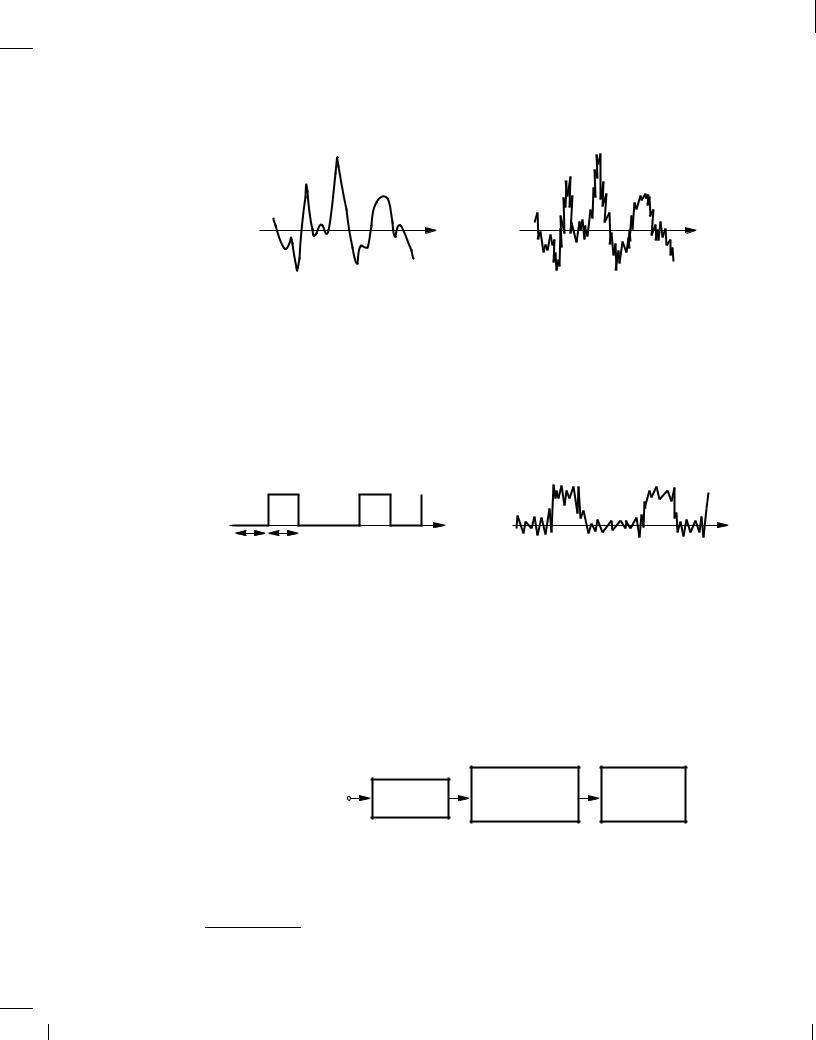
BR |
Wiley/Razavi/Fundamentals of Microelectronics [Razavi.cls v. 2006] |
June 30, 2007 at 13:42 |
8 (1) |
|
|
|
|
8 |
Chap. 1 |
Introduction to Microelectronics |
waveforms. Shown in Fig. 1.9(a), an analog voltage waveform swings through a “continuum” of
V ( t
(
V ( t
(
+ Noise
t |
t |
(a) |
(b) |
Figure 1.9 (a) Analog signal , (b) effect of noise on analog signal.
values and provides information at each instant of time.
While occurring all around us, analog signals are difficult to “process” due to sensitivities to such circuit imperfections as “noise” and “distortion.” 5 As an example, Figure 1.9(b) illustrates the effect of noise. Furthermore, analog signals are difficult to “store” because they require “analog memories” (e.g., capacitors).
By contrast, a digital signal assumes only a finite number of values at only certain points in time. Depicted in Fig. 1.10(a) is a “binary” waveform, which remains at only one of two levels for
V ( t ( |
ONE |
|
V ( t ( + Noise |
ZERO |
|
|
|
T |
T |
t |
t |
|
|
||
|
|
(a) |
(b) |
Figure 1.10 (a) Digital signal, (b) effect of noise on digital signal.
each period, T . So long as the two voltages corresponding to ONEs and ZEROs differ sufficiently, logical circuits sensing such a signal process it correctly—even if noise or distortion create some corruption [Fig. 1.10(b)]. We therefore consider digital signals more “robust” than their analog counterparts. The storage of binary signals (in a digital memory) is also much simpler.
The foregoing observations favor processing of signals in the digital domain, suggesting that inherently analog information must be converted to digital form as early as possible. Indeed, complex microelectronic systems such as digital cameras, camcorders, and compact disk (CD) recorders perform some analog processing, “analog-to-digital conversion,” and digital processing (Fig. 1.11), with the first two functions playing a critical role in the quality of the signal.
Analog |
Analog |
Analog−to−Digital |
Digital |
|
Processing |
||||
Signal |
Conversion |
|||
Processing |
and Storage |
|||
|
|
Figure 1.11 Signal processing in a typical system.
It is worth noting that many digital binary signals must be viewed and processed as analog waveforms. Consider, for example, the information stored on a hard disk in a computer. Upon retrieval, the “digital” data appears as a distorted waveform with only a few millivolts of amplitude
5Distortion arises if the output is not a linear function of input.

BR |
Wiley/Razavi/Fundamentals of Microelectronics [Razavi.cls v. 2006] |
June 30, 2007 at 13:42 |
9 (1) |
|
|
|
|
Sec. 1.3 |
Basic Concepts |
9 |
(Fig. 1.12). Such a small separation between ONEs and ZEROs proves inadequate if this signal
~3 mV
Hard |
t |
|
Disk |
||
|
Figure 1.12 Signal picked up from a hard disk in a computer.
is to drive a logical gate, demanding a great deal of amplification and other analog processing before the data reaches a robust digital form.
1.3.2 Analog Circuits
Today's microelectronic systems incorporate many analog functions. As exemplified by the cellphone and the digital camera studied above, analog circuits often limit the performance of the overall system.
The most commonly-used analog function is amplification. The signal received by a cellphone or picked up by a microphone proves too small to be processed further. An amplifier is therefore necessary to raise the signal swing to acceptable levels.
The performance of an amplifier is characterized by a number of parameters, e.g., gain, speed, and power dissipation. We study these aspects of amplification in great detail later in this book, but it is instructive to briefly review some of these concepts here.
A voltage amplifier produces an output swing greater than the input swing. The voltage gain, Av, is defined as
A = vout : |
(1.1) |
v vin
In some cases, we prefer to express the gain in decibels (dB):
A j |
dB |
= 20 log |
vout |
: |
(1.2) |
|
|||||
v |
|
vin |
|
|
|
|
|
|
|
|
For example, a voltage gain of 10 translates to 20 dB. The gain of typical amplifiers falls in the range of 101 to 105.
Example 1.3
A cellphone receives a signal level of 20 V, but it must deliver a swing of 50 mV to the speaker that reproduces the voice. Calculate the required voltage gain in decibels.
Solution
We have
Av = 20 log |
50 mV |
(1.3) |
|
20 V |
|
68 dB: |
(1.4) |
|
Exercise
What is the output swing if the gain is 50 dB?
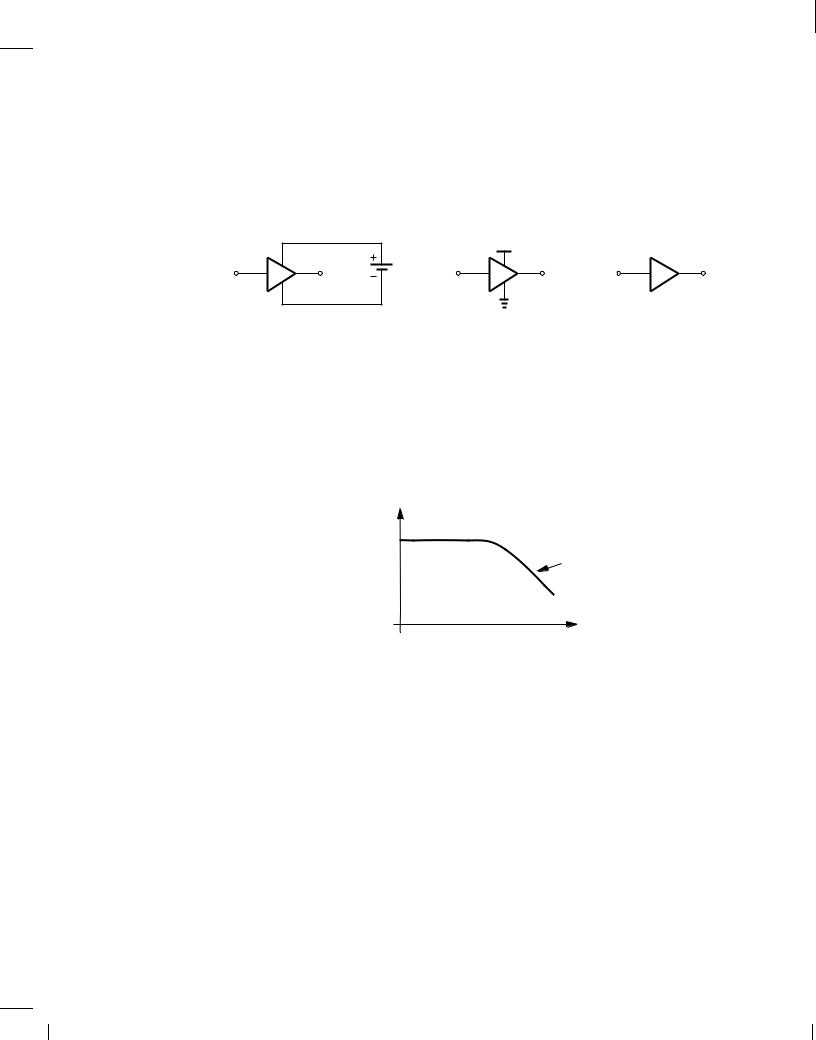
BR |
Wiley/Razavi/Fundamentals of Microelectronics [Razavi.cls v. 2006] |
June 30, 2007 at 13:42 |
10 (1) |
|
|
|
|
10 |
Chap. 1 |
Introduction to Microelectronics |
In order to operate properly and provide gain, an amplifier must draw power from a voltage source, e.g., a battery or a charger. Called the “power supply,” this source is typically denoted by VCC or VDD [Fig. 1.13(a)]. In complex circuits, we may simplify the notation to that shown in
Amplifier
|
|
|
|
VCC |
|
|
Vin |
Vout |
VCC |
Vin |
Vout |
Vin |
Vout |
|
||||||
|
|
|
|
Ground |
|
|
|
(a) |
|
|
(b) |
|
(c) |
Figure 1.13 (a) General amplifier symbol along with its power supply, (b) simplified diagram of (a), (b) amplifier with supply rails omitted.
Fig. 1.13(b), where the “ground” terminal signifies a reference point with zero potential. If the amplifier is simply denoted by a triangle, we may even omit the supply terminals [Fig. 1.13(c)], with the understanding that they are present. Typical amplifiers operate with supply voltages in the range of 1 V to 10 V.
What limits the speed of amplifiers? We expect that various capacitances in the circuit begin to manifest themselves at high frequencies, thereby lowering the gain. In other words, as depicted in Fig. 1.14, the gain rolls off at sufficiently high frequencies, limiting the (usable) “bandwidth”
Amplifier Gain
Figure 1.14 Roll-off an amplifier's gain at high frequencies.
High−Frequency
Roll−off
Frequency
of the circuit. Amplifiers (and other analog circuits) suffer from trade-offs between gain, speed and power dissipation. Today's microelectronic amplifiers achieve bandwidths as large as tens of gigahertz.
What other analog functions are frequently used? A critical operation is “filtering.” For example, an electrocardiograph measuring a patient's heart activities also picks up the 60-Hz (or 50-Hz) electrical line voltage because the patient's body acts as an antenna. Thus, a filter must suppress this “interferer” to allow meaningful measurement of the heart.
1.3.3 Digital Circuits
More than 80% of the microelectronics industry deals with digital circuits. Examples include microprocessors, static and dynamic memories, and digital signal processors. Recall from basic logic design that gates form “combinational” circuits, and latches and flipflops constitute “sequential” machines. The complexity, speed, and power dissipation of these building blocks play a central role in the overall system performance.
In digital microelectronics, we study the design of the internal circuits of gates, flipflops, and other components. For example, we construct a circuit using devices such as transistors to
